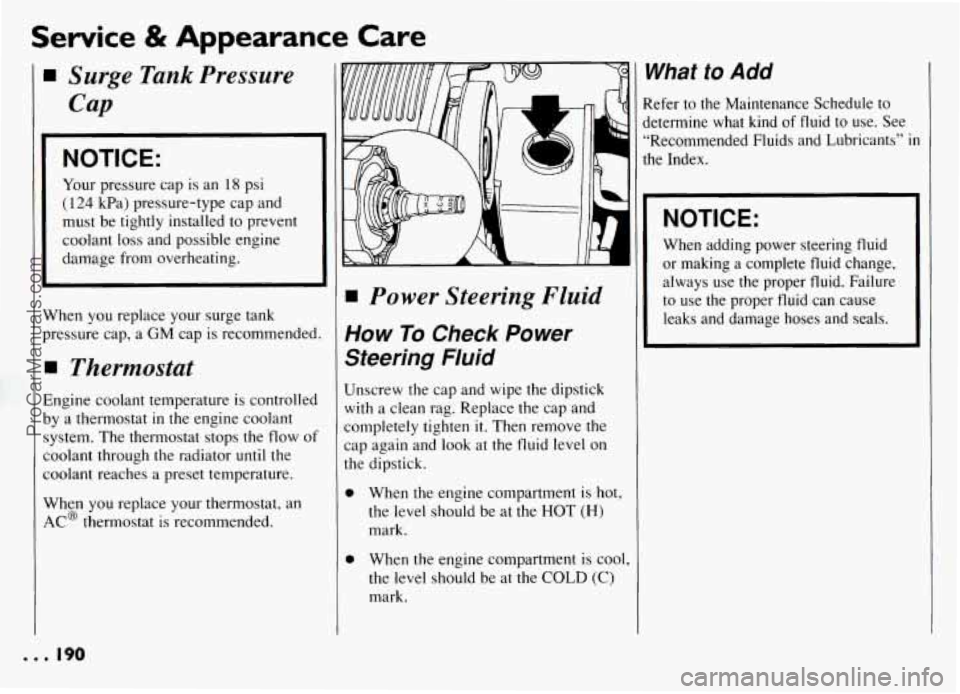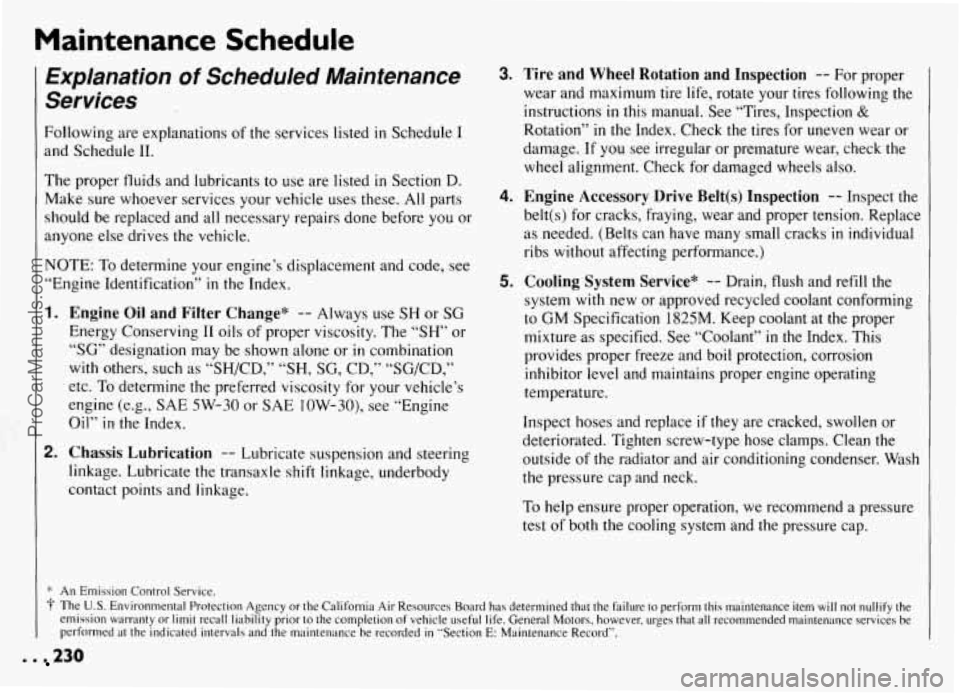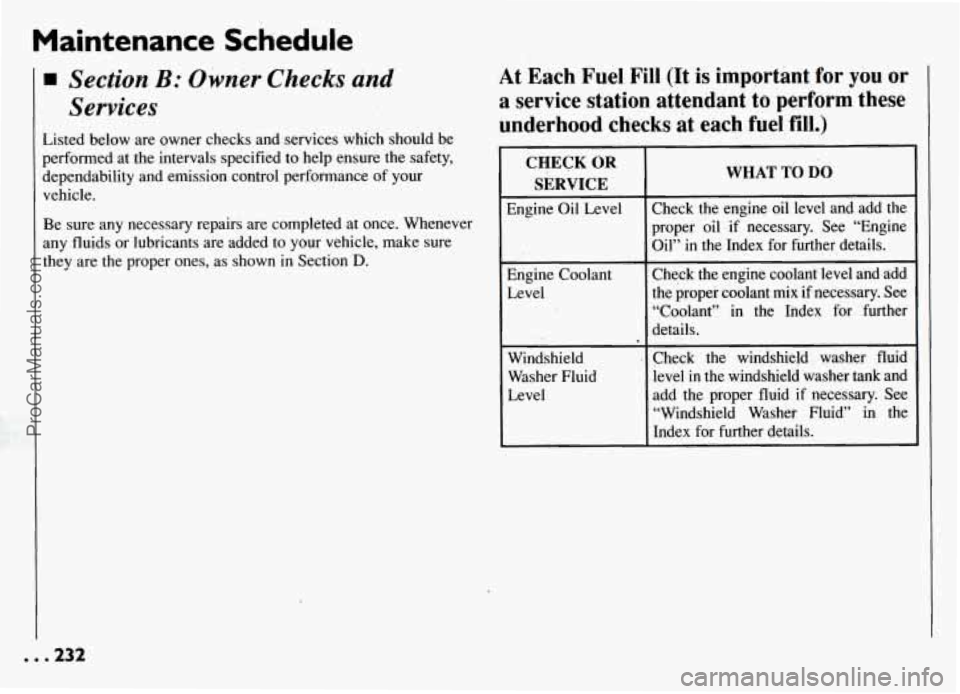1994 PONTIAC GRAND-AM coolant level
[x] Cancel search: coolant levelPage 191 of 274

Service & Appearance Care
V
P
I
E
b
S’
C
C.
P
A
I Surge Tank Pressure
Cap
NOTICE:
Your pressure cap is an 18 psi
( 124 kPa) pressure-type cap and
must be tightly installed to prevent
coolant
loss and possible engine
damage from overheating.
irhen you replace your surge tank
ressure cap, a GM cap is recommended.
I Thermostat
lngine coolant temperature is controlled
y a thermostat in the engine coolant
ystem. The thermostat stops the flow
of
oolant through the radiator until the
oolant reaches a preset temperature.
Jhen you replace your thermostat, an
.C@ thermostat is recommended.
Power Steering Fluid
How To Check Power
Steering Fluid
Unscrew the cap and wipe the dipstick
with a clean rag. Replace the cap and
completely tighten
it. Then remove the
cap again and
look at the fluid level on
the dipstick.
0
0
When the engine compartment is hot,
the level should be at the HOT
(H)
mark.
When the engine compartment is cool,
the level should be at the
COLD (C)
mark.
1
I
1
What to Add
Refer to the Maintenance Schedule to
jetermine what kind
of fluid to use. See
“Recommended Fluids and Lubricants”
in
the Index.
NOTICE:
When adding power steering fluid
or making a complete fluid change,
always use the proper fluid. Failure
to use the proper fluid can cause
leaks and damage hoses and seals.
... 190
ProCarManuals.com
Page 231 of 274

Maintenance Schedule
Explanation of Scheduled Maintenance
Services
Following are explanations of the services listed in Schedule I
and Schedule 11.
The proper fluids and lubricants to use are listed in Section D.
Make sure whoever services your vehicle uses these. All parts
should be replaced and all necessary repairs done before you or
anyone else drives the vehicle.
NOTE: To determine your engine’s displacement and code, see
“Engine Identification”
in the Index.
1.
2.
Engine Oil and Filter Change* -- Always use SH or SG
Energy Conserving I1 oils of proper viscosity. The “SH” or
“SG” designation may be shown alone or in combination
with others, such as “SH/CD,” “SH, SG, CD,” “SG/CD,”
etc. To determine the preferred viscosity for your vehicle’s
engine (e.g., SAE 5W-30 or SAE 10W-30), see “Engine
Oil”
in the Index.
Chassis Lubrication -- Lubricate suspension and steering
linkage. Lubricate the transaxle shift linkage, underbody
contact points and linkage.
3.
4.
5.
Tire and Wheel Rotation and Inspection -- For proper
wear and maximum tire life, rotate your tires following the
instructions
in this manual. See “Tires, Inspection &
Rotation” in the Index. Check the tires for uneven wear or
damage. If you see irregular or premature wear, check the
wheel alignment, Check for damaged wheels also.
Engine Accessory Drive Belt(s) Inspection -- Inspect the
belt(s) for cracks, fraying, wear and proper tension. Replace
as needed. (Belts can have many small cracks
in individual
ribs without affecting performance.)
Cooling System Service* -- Drain, flush and refill the
system with new or approved recycled coolant conforming
to
GM Specification 1825M. Keep coolant at the proper
mixture as specified. See “Coolant”
in the Index. This
provides proper freeze and boil protection, corrosion
inhibitor level and maintains proper engine operating
temperature.
Inspect hoses and replace if they are cracked, swollen or
deteriorated. Tighten screw-type hose clamps. Clean the
outside of the radiator and air conditioning condenser. Wash
the pressure cap and neck.
To help ensure proper operation, we recommend a pressure
test of both the cooling system and the pressure cap.
. . 230
ProCarManuals.com
Page 233 of 274

Maintenance Schedule
Section B: Owner Checks and
Services
Listed below are owner checks and services which should be
performed at the intervals specified to help ensure the safety,
dependability and emission control performance of your
vehicle.
Be sure any necessary repairs are completed at once. Whenever
any fluids or lubricants are added to your vehicle, make sure
they are the proper ones, as shown in Section
D.
At Each Fuel Fill (It is important for you or
a service station attendant to perform these
underhood checks at each fuel fill.)
CHECK OR
SERVICE
Engine Oil Level
Engine Coolant
Level
Windshield
Washer Fluid
Level
WHAT TO DO
Check the engine oil level and add the
proper oil
if necessary. See “Engine
Oil”
in the Index for further details.
Check the engine coolant level and add
the proper coolant mix if necessary. See
“Coolant” in the Index for further
details.
Check the windshield washer fluid
level in the windshield washer tank and
add the proper fluid
if necessary. See
“Windshield Washer Fluid” in the
Index for further details.
ProCarManuals.com
Page 265 of 274

Index
Changing a Flat Tire ............. 162
“Check Gauges” Light
........... 100
Check Oil Light ................. 96
Engine Coolant .............. 188
Engine Oil Level
............. 179
Hydraulic Clutch
............. 187
Power Steering Fluid
......... 190
Safety Belt Systems
........... 42
Automatic ............... 184
Manual
.................. 186
Checking Things Under the Hood
. . 175
Checks
& Services. Owner ....... 232
Chemical Paint Spotting
.......... 209
Child Restraints
................. 33
Children and Safety Belts
......... 32
Circuit Breakers & Fuses ......... 2 12
Charging System Warning Light .... 97
Checking
Brake Fluid ................. 191
Transaxle Fluid
Cigarette Lighter ................ 86
City Driving
................... 132
Cleaner. Air
................... 183
Aluminum Wheels ........... 208
Antenna
.................... 1 18
Cassette Player and Tapes ...... 117
Compact Discs
.............. 11 8
Finish Damage .............. 209
Foreign Material
............. 209
Cleaning
Fabric ..................... 205
Glass ...................... 207
Inside of Your Pontiac ........ 204
Leather and Vinyl
............. 206
Outside of Your Pontiac
....... 208
Safety Belts
................. 207
Sheet Metal Damage
.......... 209
Special Problems
............ 206
Top of the Instrument Panel
.... 206
Underbody Maintenance
....... 209
Using Solvent Type Cleaner
.... 205
Warnings
........... 204.205. 207
Weatherstrips
............... 209
White Sidewall Tires
.......... 208
Windshield and Wiper Blades
... 207
Climate Control System .......... 102
Clock. Setting the
............... 107
Adding Fluid ................ 187
Checking Fluid
.............. 187
Coin Holder
.................... 86
Comfort Controls
............... 101
Air Conditioning System
...... 103
Climate Control System
....... 102
Defrosting
.................. 104
Heater
..................... 102
Ventilation
.................. 103
Clutch. Hydraulic
Compact Disc Player (see “Audio
Systems”)
Compact Spare Tire ............. 167
Control of a Vehicle
............. 122
Controlled-Cycle Windshield
Wipers ....................... 81
Convex Outside Mirror
........... 83
Coolant ....................... 188
Low Coolant Warning Light
..... 94
Safety Warnings. About
... 188. 189
Temperature Warning Light
..... 94
Thermostat ................. 190
Corrosion Protection
............ 209
Cruise Control
.................. 74
Cup Holders
.................... 85
Curves. Driving on
.............. 125
Checking & Adding .......... 188
Proper Mixture to Use
........ 188
Temperature Gage
............. 94
Customer Assistance Information . . 243
Daytime Running Lights ......... 77
Dead Battery: What to Do ........ 148
Defects. Safety. Reporting (see
“Safety Defects”)
Defensive Driving .............. 120
Defogger. Rear Window
......... 105
Defogging Your Windows
........ 102
Door Locks
..................... 47
Door. Remote Fuel Filler
......... 174
Downshifting
................ 62. 66
Driver Position .................. 17
Driving
At Night ................... 129
City
....................... 132
Controlling a Skid
............ 128
Defensive
.................. 120
Drunken
................... 120
Freeway
..................... 132
. 264
ProCarManuals.com